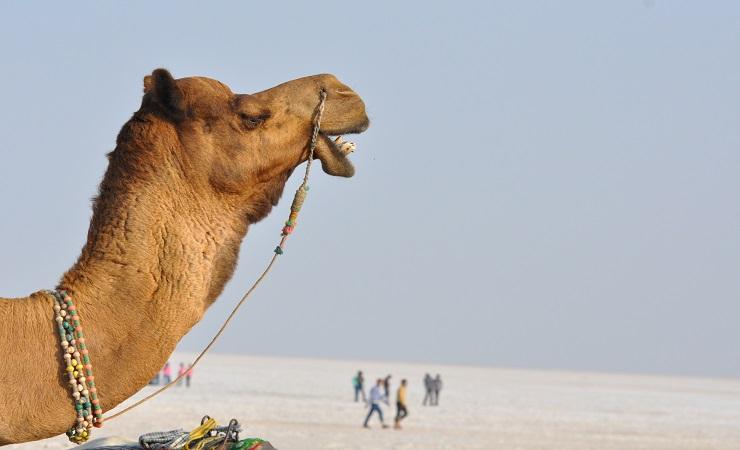ASIACALLING
India’s camel population rapidly dwindling
"Camels have been a crucial part of Indian desert life. But their numbers are fast dwindling, and some are afraid they may soon become critically endangered. "

The Indian state of Rajasthan is known for rolling desert hills, and herds of camels striding across sun-drenched sands.
The camel is Rajasthan’s state animal. But their numbers are fast dwindling, and some are afraid they may soon become critically endangered.
Asia Calling reporter Jasvinder Sehgal traveled to the Global Rajasthan Agritech meet in Udaipur, Rajasthan, to find out more.
Two camels are pounding their hooves to the beat of drums, decorated with orange saddles, nose pegs and tiny bells tied to their legs.
![]()
35 year old performer Kanjo is dancing with the camels.
“I am just like a prop for these camels,” she tells me. “For me they are like a God. I love, respect and worship them. And I can’t live without them; I rely on them to make a living.”
Kanjo sings a melody in praise of her camels. Like many people in Rajasthan, she reveres camels the way that Hindus worship cows.
Many who have brought their camels here are Raikas, a special caste of camel breeders, who believe they were created by Shiva to be camel guardians. They worship the camel god Prabuji.
![]()
80% of India’s camels are in the state of Rajasthan. The camel is crucial to the area’s art and culture, with hundreds of folktales, stories and poems dedicated to the animal.
At the agricultural meet, more camel owners arrive with various breeds of domesticated camels in tow.
56 year old Jagdeesh Raibari has been rearing camels since childhood. Today, he shares the concerns of many people here.
“Earlier my family had 150 camels but today we have far fewer. Camel rearing is not lucrative anymore,” Raibari said. “Our young people are searching for new jobs, because they can’t earn money with camels.”
![]()
In recent decades, life has become tough for Raikas, or camel rearers.
Deforestation, urbanization and climate change have encroached on grazing land.
Disease has had a big impact on camel populations.
Camels were once integral to desert life - the ships of India’s deserts. Kings kept royal herds. The animals were used extensively for transport.
But in recent decades, camels have been replaced with desert scooters, cars and trucks.
Until the 1990s, there were around one million camels in Rajasthan. According to current estimates, their numbers have fallen to less than 200 000.
![]()
In the hope of saving camels, the state government of Rajasthan has made it illegal to slaughter and export camels – elevating them to a similar status to India’s holy cow. Penalties of up to 5 years can be imposed for their slaughter.
But camel owners say the law hasn’t had the desired effect. Camel numbers are continuing to drop.
“We are demanding that the State government at least allow the export of male camels, if not, their numbers will keep dropping. Camel owners will stop rearing them because they are not economically viable,” stated Hanwant Singh Rathore, the director of the League for Pastoral Peoples. He has been campaigning for camel protection for the last 25 years.
Rathore argues if camel exports remain banned, rearing camels won’t be economically sustainable, and young Raika will continue to move to the cities and find other work.
He’s suggesting new strategies, like selling camel milk and other camel products.
![]()
Back at the meet, the air is filled with the sweet smell of tea brewing on an old stove.
Camel rearer Seeta Devi is giving out camel milk tea, and telling people about its believed health benefits.
“Camel milk has immense therapeutic value. It is beneficial for asthma, tuberculosis, diabetes and regulating blood sugar levels,” she tells passersby.
Camel milk has become a recent health food fad, and is sold at premium prices internationally.
Dr. Narender Singh is in charge of the state government’s camel conservation efforts. He argues that milk, and other camel products should be promoted. They could provide new incentive to continue rearing camels.
“Camel milk chocolate is very popular among youngsters. Handmade paper, woolen mats and rugs, and even mosquito repellent made out of camel dung are finding their way into urban markets,” he commented.
Selling new camel products might be a financial incentive for young Raika to stay with the camels. But they are still searching for answers to the bigger challenges of climate change and the desert’s destruction.
- Camels India
- Desert Rajasthan
- Camel milk
Komentar (0)
KBR percaya pembaca situs ini adalah orang-orang yang cerdas dan terpelajar. Karena itu mari kita gunakan kata-kata yang santun di dalam kolom komentar ini. Kalimat yang sopan, menjauhi prasangka SARA (suku, agama, ras dan antargolongan), pasti akan lebih didengar. Yuk, kita praktikkan!